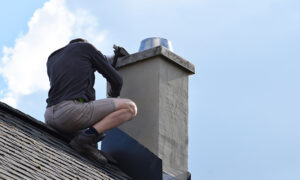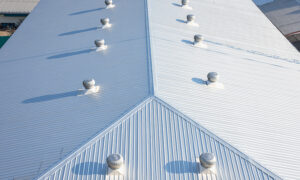A commercial roof flashing is an integral part of a commercial establishment. It plays an important role in protecting the structure from leaks and water damage. Property owners must remember to include ample flashing to ensure the safety of the building.
What Is Commercial Roof Flashing?
A commercial flashing is a thin sheet of material that covers an opening. This prevents water from getting into places it’s not meant to be, preventing water damage. The flashing redirects water flow from the roof cavity, downpipes, and gutters so it does not enter more vulnerable parts of the building.
Flashings often seal connecting points like vents, exhausts, and where shingles and appliances meet. They are most commonly placed at roof penetrations like vents and windows. Moreover, they’re used when there’s a difference in levels, heights, or a shift in direction.
Types of Commercial Roof Flashing
There are various types of commercial roof flashing in the industry.
 Apron Flashing. Used when vertical surfaces and sloped roofs meet like walls and chimneys. They channel water from the vertical surface and redirect it toward the roof.
Apron Flashing. Used when vertical surfaces and sloped roofs meet like walls and chimneys. They channel water from the vertical surface and redirect it toward the roof.- Cap or Counter Flashing. Prevents water from coming in behind the sidewall flashing or the headwall’s vertical flange. It’s usually used along with base flashing for proper installation.
- Continuous Flashing. A long piece of continuous flashing that often substitutes for step flashing.
- Corner Flashing. Located on the exterior end of a roof where it joins an exterior wall. It prevents water from flowing into the nooks between the walls and roofs.
- Eaves Roof Flashing. Serves as a waterproof seal. Protects the roof framing from moisture.
- Inverted Corner Flashing. Located at corners where walls and roofs meet. They seal the gaps between the wall and the structure.
- Kickout Flashing. Designed to direct water from walls into gutters, especially where a sidewall meets the edge of a roof.
- Ridge Flashing. Prevents water from flowing between the insides of the ceiling and the roof. It’s often installed on dually sloped roofs with steep slopes.
- Saddle Roof Flashing. Installed for railing attachments, beams going through external walls, and cantilevered joists. They protect against water penetration from ice dams and melting snow.
- Step Flashing. Consists of multiple overlapping pieces, creating a “step” formation. They are used where vertical walls meet roofs.
- Valley Flashing. Ensures water flows from the roof into the gutters. They are installed where two sloping roofs meet in the roof’s valleys.
- Vent Pipe Flashing. Rings of metal flashings with openings. They allow the vent pipes to pass through them so water does not get between the roof and the pipe.
What Materials Are Used for Commercial Roof Flashing?
A commercial roof flashing system can use a variety of materials. They often use synthetic rubber, plastic, TPO, or PVC products. Commercial roof flashings may also use different metals, such as copper, aluminum, lead, and galvanized steel materials.
Each material has its strengths and weaknesses. For instance, rubber and plastic flashings excel at repelling water. Meanwhile, PVCs are more durable and are better suited for industrial settings like chemical plants and ships. Other materials may not last as long as PVCs in industrial structures because these environments often have high pH levels.
As for aluminum, they’re the most affordable choice and are easy to install. However, they may rust when they come into contact with alkaline materials. Meanwhile, copper flashings with lead coating are great to pair with components from solar panels as they increase reliability. Lead flashings are also preferable for flexibility and longevity. Finally, galvanized steel flashings are popular because they’re cheap. However, they’re not as durable as other materials.
Why Is Commercial Roof Flashing Important?
Most property owners think that sealants are good enough for waterproofing. That’s why many don’t think of installing a commercial roof flashing. However, they’re essential to protect the commercial building and extend the property’s lifespan. Here are some reasons why they’re important.
1. Weather Protection
A commercial roof flashing will protect the property from wind and rain. Without flashings, the property will be at risk of leaks when it rains. It’s also more vulnerable during the winter as temperatures dip below freezing point. Meanwhile, the summertime heat waves may damage the building and leave it without any protection.
2. Aesthetic Appeal
Beauty and aesthetics are vital to any commercial establishment. After all, the building’s facade and aesthetic appeal can draw customers in or keep them away. Commercial buildings with roof flashings often look more appealing and polished.
3. Property Value Protection
Water is one of the most pernicious substances that can damage commercial structures. If the building leaks, it may disrupt the establishment’s daily operations. The water will soak carpets, damage the ceilings, and eat away at various appliances. A commercial roof flashing will protect the building from leaks and water damage. This safeguards the property owner’s investment and enhances property value.
Maintenance for Commercial Roof Flashing
 New commercial roofs and their flashings often don’t need maintenance. The materials contractors use for roof flashings are often made to last. When properly installed, they are not easily damaged by prolonged use or weather conditions. However, contractors must ensure the rooftop is fitted with the right material for each use case.
New commercial roofs and their flashings often don’t need maintenance. The materials contractors use for roof flashings are often made to last. When properly installed, they are not easily damaged by prolonged use or weather conditions. However, contractors must ensure the rooftop is fitted with the right material for each use case.
On the other hand, while flashings are built to last, they will need some upkeep as the roof ages. After some time, the property owner must inspect the commercial roof flashing annually and look for signs of breakdown or damage. Doing so will help the contractor spot any issues early and make minor repairs. If the property owner skips out on inspections, they may need major repairs.
Protect Your Property
A commercial roof flashing is critical to the structural integrity of any commercial structure. It is often a necessary addition to commercial buildings as it protects the building itself and its contents. Property owners must pay careful attention to roof flashings to protect their investments.
Are you in need of professional help to maintain your commercial building? Maintenance Specialists, Inc. can assist you. We provide high-quality maintenance services for commercial properties. Give us a call today at 704.405.6000 or get in touch with us online for more information!
RELATED ARTICLES:
- What Are The Most Common Commercial Building Structure Violations In The US?
- Why Is Sealing Air Barriers Penetrations In A Commercial Building Crucial?
- What Is Fire Blocking In Commercial Establishments For?

